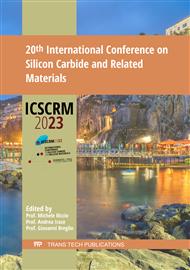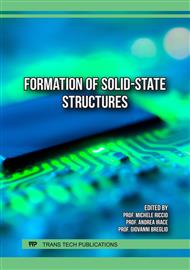p.157
p.163
p.171
p.181
p.187
p.193
p.201
p.211
p.217
Increasing 4H-SiC Trench Depth by Improving the Dry Etch Selectivity towards the Oxide Hard Mask
Abstract:
This work presents the results of process development for trench formation in SiC power devices to increase the trench depth by improving SiC/SiO2-selectivity of the dry etch process. Motivation behind this development is to further improve the electrical properties of conventional devices like SiC MOSFETs by implementing a trench geometry, allowing the cell pitch to be increased, leading to a reduced on-resistance of SiC TrenchMOS devices. Trench etching was performed on 4H-SiC substrates by utilizing an oxide hard mask, patterned by photolithography and dry etching. The SiC trench profile was analyzed by cross-section preparation via FIB and SEM imaging. The highest SiC/SiO2-selectivity achieved was 7.9, with SiF4 gas flow being the most decisive parameter for it. With that, the selectivity of the standard SiC trench etch process was increased by nearly five times. SiC trenches with depths of 5 µm could be demonstrated. However, then the structural fidelity was deteriorated, with micro-trenching and sidewall bowing being the largest limitations regarding applicable trench depth in SiC power devices.
Info:
Periodical:
Pages:
193-200
Citation:
Online since:
August 2024
Authors:
Keywords:
Permissions:
Share:
Citation:



